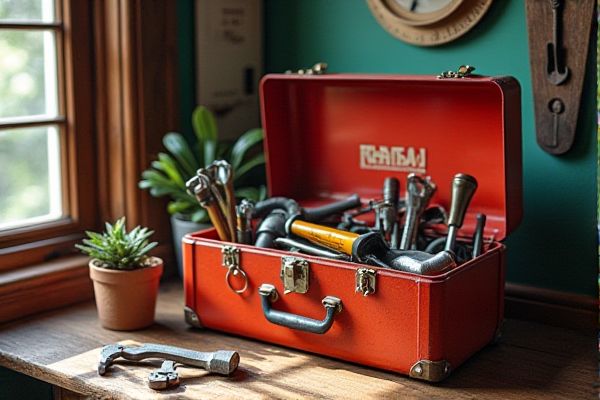
A toolbox offers structured compartments and robust protection for organizing and transporting tools, making it ideal for heavy-duty use and professional settings. To discover which option suits Your needs best and explore detailed comparisons, continue reading the rest of the article.
Table of Comparison
| Feature | Toolbox | Tool Bag |
|---|---|---|
| Material | Metal or hard plastic | Durable fabric or leather |
| Portability | Rigid, less flexible | Lightweight, flexible |
| Capacity | Fixed compartments | Expandable space |
| Protection | High protection against impact | Moderate protection |
| Weight | Heavier, sturdy | Lighter, easy to carry |
| Organization | Structured with trays | Flexible, uses pouches |
| Common Use | Mechanics, electricians | Contractors, DIY enthusiasts |
| Price Range | Moderate to high | Low to moderate |
Toolbox vs Tool Bag: Key Differences
A toolbox offers rigid structure and organized compartments, ideal for heavy-duty tools and protection during transport, while a tool bag provides flexibility, lightweight design, and easy portability for smaller or frequently used tools. Toolboxes are typically made from metal or hard plastic, ensuring durability and secure storage, whereas tool bags use fabric materials that allow expansion and multiple external pockets for accessibility. Choosing between a toolbox and a tool bag depends on the type of tools, usage frequency, and the need for mobility versus protection.
Portability: Which Is Easier to Carry?
Tool bags offer superior portability due to their lightweight fabric construction and flexible design, allowing for easier carrying and storage in tight spaces. Toolboxes, often made from hard plastic or metal, provide rigid protection but tend to be bulkier and heavier, making them less convenient for frequent transport. When considering ease of carrying, your choice depends on whether you prioritize lightweight mobility or durable protection for your tools.
Storage Capacity and Organization
Toolboxes typically offer rigid compartments and removable trays that enhance organization and secure storage of heavy tools, supporting better capacity for diverse tool sizes. Tool bags provide flexible storage with multiple pockets and expandable sections, allowing for easier portability but sometimes less structured organization. Storage capacity in toolboxes is generally larger and more durable, while tool bags prioritize lightweight design and convenience over maximum volume.
Durability and Material Comparison
Toolboxes typically offer superior durability due to their construction from heavy-duty materials like metal or rigid plastic, providing enhanced protection against impacts and harsh conditions. Tool bags are usually made from durable fabrics such as nylon or polyester, offering flexibility and lighter weight but less resistance to crushing or water exposure. When choosing, your decision should consider whether you need robust, long-lasting storage or portability and ease of access.
Accessibility and Ease of Use
A toolbox offers structured compartments and rigid walls, providing quick access and better organization for your tools during projects. A tool bag is typically lighter and more portable, with flexible storage that allows you to grab tools quickly in tight spaces. Your choice depends on whether you prioritize accessibility in a stationary workspace or ease of use on the go.
Ideal Use Cases for Toolboxes
Toolboxes offer organized storage with compartments ideal for professionals requiring systematic access to tools, especially in automotive repair, construction, and electronics. Their rigid structure protects delicate instruments and heavy-duty tools, making them suitable for workshops or on-site jobs where durability is essential. Compared to tool bags, toolboxes provide better protection and organization for extensive tool collections, enhancing efficiency and tool longevity.
Best Scenarios for Tool Bags
Tool bags excel in scenarios requiring portability and quick access, making them ideal for electricians, plumbers, and handymen working on-site or in tight spaces. Unlike rigid toolboxes, tool bags are lightweight, flexible, and often feature multiple compartments to organize small tools and accessories efficiently. Your ease of transport and ability to carry essential tools comfortably make tool bags the preferred choice for mobile professionals and home DIY projects alike.
Cost Comparison: Toolbox vs Tool Bag
Tool bags generally offer a lower upfront cost compared to toolboxes, making them a budget-friendly option for casual users and small projects. Toolboxes, often constructed from durable materials like metal or heavy-duty plastic, tend to have a higher price point but provide long-term value through enhanced protection and organization. Evaluating cost-effectiveness depends on factors such as frequency of use, tool weight, and the need for portability versus sturdiness.
Maintenance and Longevity
A toolbox offers structured compartments and durable materials like metal or heavy-duty plastic, enhancing maintenance by preventing tool damage and organizing tools efficiently. Tool bags, often made from fabric or leather, provide flexibility and portability but may wear out faster due to exposure to elements and frequent handling. Investing in a high-quality toolbox increases tool longevity by minimizing exposure to moisture and impact, whereas tool bags require regular cleaning and care to maintain their durability over time.
Choosing the Right Option for Your Needs
Selecting between a toolbox and a tool bag hinges on durability, portability, and tool organization needs; toolboxes typically offer rigid protection and structured compartments for heavy-duty tools, while tool bags provide lightweight flexibility and easy transport for smaller, frequently used items. Consider the volume and type of tools you own--toolboxes suit professionals requiring secure storage for larger tools, whereas tool bags excel for DIY enthusiasts needing quick access and mobility. Evaluating your work environment and the weight of your tool collection ensures choosing the right option for efficiency and convenience.
 homyna.com
homyna.com